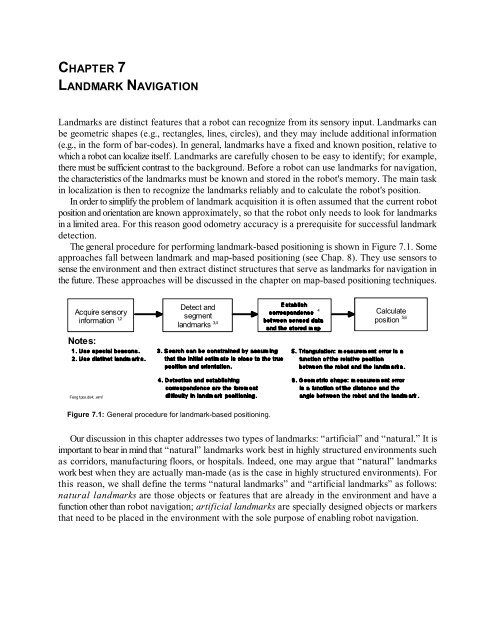Where am I? Sensors and Methods for Mobile Robot Positioning
Where am I? Sensors and Methods for Mobile Robot Positioning
Where am I? Sensors and Methods for Mobile Robot Positioning
Create successful ePaper yourself
Turn your PDF publications into a flip-book with our unique Google optimized e-Paper software.
CHAPTER 7<br />
LANDMARK NAVIGATION<br />
L<strong>and</strong>marks are distinct features that a robot can recognize from its sensory input. L<strong>and</strong>marks can<br />
be geometric shapes (e.g., rectangles, lines, circles), <strong>and</strong> they may include additional in<strong>for</strong>mation<br />
(e.g., in the <strong>for</strong>m of bar-codes). In general, l<strong>and</strong>marks have a fixed <strong>and</strong> known position, relative to<br />
which a robot can localize itself. L<strong>and</strong>marks are carefully chosen to be easy to identify; <strong>for</strong> ex<strong>am</strong>ple,<br />
there must be sufficient contrast to the background. Be<strong>for</strong>e a robot can use l<strong>and</strong>marks <strong>for</strong> navigation,<br />
the characteristics of the l<strong>and</strong>marks must be known <strong>and</strong> stored in the robot's memory. The main task<br />
in localization is then to recognize the l<strong>and</strong>marks reliably <strong>and</strong> to calculate the robot's position.<br />
In order to simplify the problem of l<strong>and</strong>mark acquisition it is often assumed that the current robot<br />
position <strong>and</strong> orientation are known approximately, so that the robot only needs to look <strong>for</strong> l<strong>and</strong>marks<br />
in a limited area. For this reason good odometry accuracy is a prerequisite <strong>for</strong> successful l<strong>and</strong>mark<br />
detection.<br />
The general procedure <strong>for</strong> per<strong>for</strong>ming l<strong>and</strong>mark-based positioning is shown in Figure 7.1. Some<br />
approaches fall between l<strong>and</strong>mark <strong>and</strong> map-based positioning (see Chap. 8). They use sensors to<br />
sense the environment <strong>and</strong> then extract distinct structures that serve as l<strong>and</strong>marks <strong>for</strong> navigation in<br />
the future. These approaches will be discussed in the chapter on map-based positioning techniques.<br />
Acquire sensory<br />
in<strong>for</strong>mation 1,2<br />
Notes:<br />
Detect <strong>and</strong><br />
4<br />
Calculate<br />
segment<br />
position 5,6<br />
l<strong>and</strong>marks 3,4<br />
Feng1pos.ds4; .wmf<br />
Figure 7.1: General procedure <strong>for</strong> l<strong>and</strong>mark-based positioning.<br />
Our discussion in this chapter addresses two types of l<strong>and</strong>marks: “artificial” <strong>and</strong> “natural.” It is<br />
important to bear in mind that “natural” l<strong>and</strong>marks work best in highly structured environments such<br />
as corridors, manufacturing floors, or hospitals. Indeed, one may argue that “natural” l<strong>and</strong>marks<br />
work best when they are actually man-made (as is the case in highly structured environments). For<br />
this reason, we shall define the terms “natural l<strong>and</strong>marks” <strong>and</strong> “artificial l<strong>and</strong>marks” as follows:<br />
natural l<strong>and</strong>marks are those objects or features that are already in the environment <strong>and</strong> have a<br />
function other than robot navigation; artificial l<strong>and</strong>marks are specially designed objects or markers<br />
that need to be placed in the environment with the sole purpose of enabling robot navigation.

















